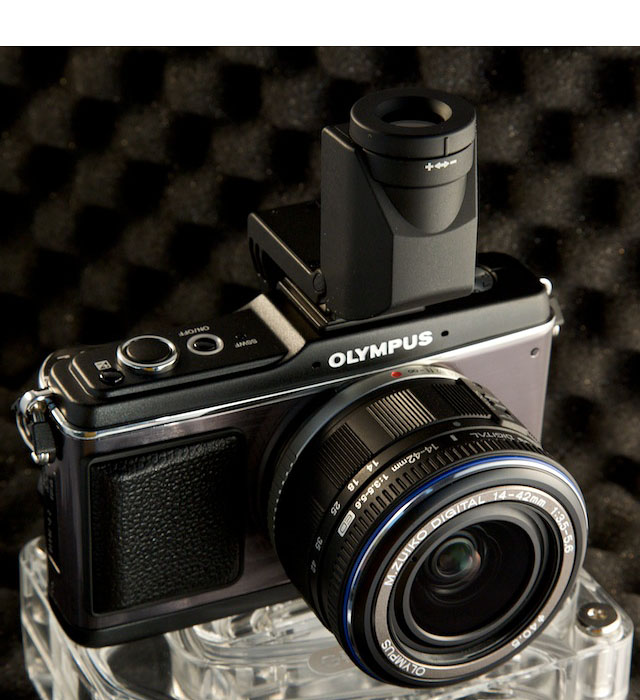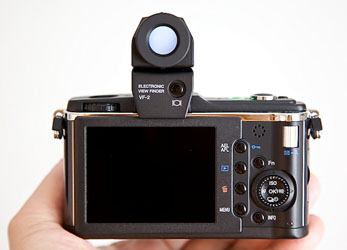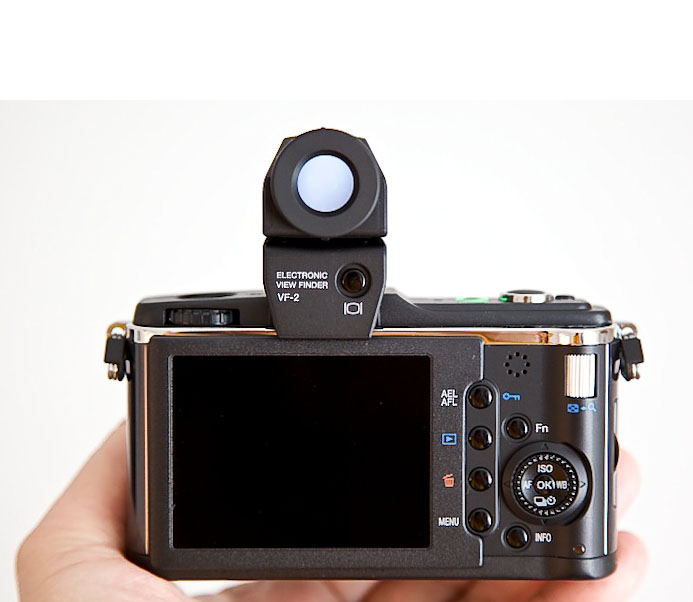Olympus placed a sizable bet that four features would carry the new E-P2: the black metallic body, continuous autofocus tracking, EMA-1 microphone adapter, and the VF-2 Electronic Viewfinder. So, today, I'm going take a look through the VF-2 and tell you what I see.
Let's start with the physical aspects. The VF-2 does add height to the camera. Without the viewfinder attached, the E-P2 is 2.75 inches (30mm) tall. When you mount the viewfinder in the hot shoe, the height of the camera increases to 4.25 inches. The VF-2 communicates with the camera through a data port on the back of the hot shoe. Keep in mind that the Olympus E-P1 does not have this data port, so the electronic viewfinder can only be used with the E-P2. It's easy to mount because all you have to do is slide it in the hot shoe and everything lines up nicely. The VF-2 is very light and it comes with a pouch to protect it when not in use.
The viewfinder is mounted with a hinge that enables you to rotate it upward as far as 90 degrees. So if you want to shoot at a lower angle, you can look down into the VF-2 to compose your shot and operate the controls. This feature adds a lot of versatility to the handling of the E-P2.
The electronic viewfinder is very responsive as you zoom through the range of the 14-42mm lens, providing virtual realtime composition. The refresh rate is decent, normal for an electronic viewfinder. If you pan quickly in any direction, there's a slight blurring during the pan, but the image becomes crisp the instant you stop.
Once thing to keep in mind with the VF-2 is that is comes with the camera. When you buy the Olympus E-P2 for $1,099, it's included in the kit with the 14-42mm lens. Now that doesn't mean that you have to use the electronic viewfinder to take pictures. When it's not mounted, the camera behaves as you would expect. The 3-inch, 230,000 dot LCD lights up ready for you to compose your shot.
When you slide the VF-2 into the hot shoe, it remains inactive until you turn it on using the button on the back. This switches the image signal from the LCD to the VF-2. You can't have both on at once. It's one or the other. But the camera does remember which one you used last when you power down. So if you were using the VF-2 when you turned off the E-P2, it would be active when you powered back up. Same goes for the LCD.
Looking through the electronic viewfinder is fun. It's bright and sharp. You can adjust the diopter ring around the eyepiece to fine tune the image for your vision. It has a long eye relief so you can use it while wearing glasses and still see the image corner to corner. When it's bright outside, the VF-2 is a welcome relief compared to trying to discern the image on the LCD. When the lights are low, it brightens up the scene making it easier to compose.
If you're used to judging exposure off the LCD, however, then the VF-2 might throw you for a curve because it does brighten up the composition. I recommend that you switch to the LCD temporarily by pushing the VF-2 button, judge your exposure, then switch back to the viewfinder. Another route to go is to press the Info button on the back of the camera to enable the live histogram. It looks great in the VF-2, and it's a more accurate way to judge exposure.
You can use the VF-2 for anything that you would use the LCD for. Menus are crisp and easy to read. Looking at your images via playback is like viewing them on a small, sharp TV screen. And since the VF-2 is removable, you can stash it in your pocket or camera kit when you want to keep a low profile, such as shooting with the 17mm lens and the LCD.
How often you use the electronic viewfinder will depend on your shooting style. In my case, I found it very helpful outside in bright light and for low angle photography. It seems easy on the battery, so there might be some savings there compared to leaving the LCD on all of the time. And when you mount it on the E-P2, it's quite secure. So you don't have to worry about it sliding off the camera. If you decide that the VF-2 Electronic Viewfinder just isn't your cup of tea, you can go with the Olympus E-P1, and save yourself $300. Both options give you a quality micro four thirds camera.
More on the Olympus E-P2
Olympus E-P2 Black Body and Electronic Viewfinder
-
















I'm very intrigued with this viewfinder. I currently use vintage OM lenses on my E-p1 and I wonder if focusing would be easier with the viewfinder. What is your opinion, and can you look at the zoomed view through the viewfinder.
Great question, Cornelis.
I don't have vintage OM lenses, but I do have manual focus Zeiss lenses that I mount on the E-P2 with a Rayqual adapter. Personally, I think it's a lot easier to use the manual focus lenses with the VF-2 electronic viewfinder. I was never that comfortable focusing them on the LCD. It just didn't give me enough resolution. But the electronic viewfinder is much clearer, and for me, a must when using these older lenses.
One other note about using older manual focus lenses on the E-P2 with the VF-2 electronic viewfinder: The view through the lens seems the same in terms of field of view, regardless is I'm using the LCD or VF-2. What's different is the clarity, much better through the electronic viewfinder.
"you can go with the Olympus E-P1, and save yourself $300."
More than that. Holiday sale prices have dropped the price of the E-P1 + zoom + plus BlackRapid strap + 4Gb card to $660 at Calumet, and the body+lens is $700ish at other places.
Great tip Elliot! The E-P1 is basically the same camera, but without the accessory port and a few other features. The image sensor, processing engine, and LCD are all the same.
I really like the idea of being able to rotate the finder upward 90 degrees and hold the camera at chest level. This is an ideal height for many kinds of people pictures, or when the camera is on a tripod.
But... what if I want to shoot vertical pictures? This would require a swivel base on the finder, but it doesn't look as if the VF-2 has one... does it?
Good point Ranger 9. The VF-2 does not swivel for vertical shots. That probably would have added to the size of the viewfinder.
You mention the height of the E-P2 without the viewfinder (30mm - which astoundingly turns out to be a bit under half the height of my E-P1 - who'd have thought it was so comparatively small just by looking at pictures of it) but you don't get round to properly mentioning the height with the VF2 attached.
Actually the height of the E-P2 is almost the same as the E-P1. I should have written 70mm for the height of the E-P2. So sorry!
Processing engine is not the same as the E-P1. Expect some improved results.
Tim, I'm curious about your statement that, "Processing engine is not the same as the E-P1. Expect some improved results." What are you basing that on?
Both the E-P1 and the E-P2 use the TruePic V Image Processor and the 12.3 MP Live MOS image sensor.
Derrick,
Does the E-P2 focus faster then the E-P1, and have you used the Panasonic GF1? If you had how do they compare and what and why do you prefer one to the other?
Thanks
Hi Derrick
Re: EVF brightness
You can actually reduce the EVF screen's brightness with the utility inside the Toolbox 1 camera menu. There's no need to switch to the 3" LCD screen. Else it defeats the purpose of the EVF.
KH
Just thought you'd be interested to know that I have saved your site to my bookmarks.
I've check out your other blog posts too and I {can say|think| you've got great ideas|content. Keep it up|going!
Just thought you'd be interested to know that I have added your blog to my bookmarks.
I've seen your other blog topics too and I {can say|think| you've got great ideas|content. Keep it up|going!
I guess I'm gonna need to read up some more but this is a really good spring board.
How does the VF2 work with the voigtlander mount and an M series lens? Does it recognize the focal length and adjust your field of view? Or does it only work with actual four thirds lenses?
Thank you!
Did you test battery life with the EVF in and out?
Thanks for the post!
You said, 'Without the viewfinder attached, the E-P2 is 2.75 inches (30mm) tall' you need to get a ruler. 30mm is just over an inch. 2.75 inches is 67.37mm.